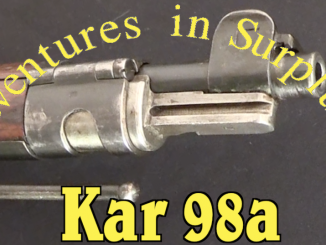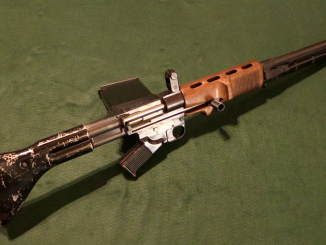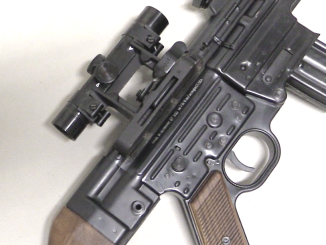RIA’s catalog page for this mortar
The 5cm 5CM Leichte Granatwerfer 36 was the standard German light infantry mortar going into World War Two. It was designed by Rheinmetall-Borsig in the mid 1930s and adopted in 1936. It fired a 0.9kg / 2 pound mortar bomb with a range of up to 550 meters. In theory, it occupied the same role as the French Mle 1937 50mm light mortar – except it was far heavier than was practical, and substantially more complex to use. The LeGrW 36 weighed in at a hefty 31 pounds (14kg) – nearly four times as much as its French counterpart.
It was a striker fired design, with a trigger lever and thus did not fire immediately upon a round being loaded. It used adjustments in angle to determine range, with a constant projectile velocity (as opposed to venting a varying amount of propellent gas to adjust range). By the middle of the war, it was being pulled out of front-line use, as its weight and relative complexity made it impractical for its intended role.




Striker-fire mortars are more complex than drop-fire mortars, but let’s consider the trade-off. A drop-fire mortar is easy to build, but requires someone to stand right next to the muzzle the whole time-not reassuring if the mortar isn’t concealed from enemy rifle/machine gun fire, and I’d hate to see the results of a nervous person letting go of the mortar round BEFORE the sergeant tells him to fire. Crouching while holding the mortar round at the muzzle can be a little… uncomfortable.
Trigger/lanyard mortars have better control over when they shoot (no misplaced shots because we don’t have a mortar guy with sweaty hands dropping stuff by accident), but require more resources and tend to be built heavier around the trigger area (we can’t have a fragile trigger mechanism/housing, or else the crew is screwed!). At least one can also insert rounds from behind cover more easily (not required to crouch perfectly still with the round in hand). However, I wonder if a mortar pit must be dug first.
From what I saw in the (very inaccurate) historical drama, The Pacific, one has to ask if using an infantry mortar to try and take out a Type 95 Ha-Go while in full view of said tank was a wise idea. Missing even once may result in the obsolete light tank decapitating/ventilating your mortar crew! Unlike the movies, there is no guarantee that the cavalry will come to save your butt!
Did I mess up?
“has to ask if using an infantry mortar to try and take out a Type 95 Ha-Go while in full view of said tank was a wise idea.”
Generally WWII infantry mortars were not designed with anti-tank capability requirement in mind. It would require to add ability to fire with low elevation, which would complicate whole weapon and also probably make it heavier. There existed designs in history able to be used like that (for example 7.58 cm Minenwerfer used during Great War), but were less common than typical (so-called Stokes-Brandt) style weapons.
However with development of guidance system mortar shells were developed able to hit engine deck of enemy tank, like for example Pansarsprängvinggranat m/94
https://en.wikipedia.org/wiki/Strix_mortar_round
4.2in chemical mortars (aka the “four-deuce”) were repeatedly shown to be highly effective as tank-killers, simply because they delivered their relatively large and powerful HE bombs onto the thin top armor of same. Something like the 5cm Le GrW 36 probably wouldn’t throw a bomb with enough HE to be noticed.
The British PIAT anti-tank weapon, a form of spigot mortar, could be used as a primitive mortar by extending its monopod, rotating its shoulder rest a quarter-turn, and placing both firmly on the ground. This allowed it to reach ranges of up to 200 meters with its rather impressively large hollow-charge bomb, and when one of those arrived on the relatively thin top armor of a German tank, that was pretty much “all she wrote” for the tank and its crew.
This trick was especially common in the bocage country in Normandy, where a line of sight direct-fire shot wasn’t always feasible.
cheers
eon
I was referring to a 60 millimeter mortar in my original post. The likely outcome of using that against an obsolete Type 95 light tank while the tank has the mortar crew in direct line of sight is a very dead mortar crew, with one crewman possibly missing his head!
Old 11-Charlie saying;
“You’re OK as long as you aren’t on Charge Zero.”
In most Western armies’ mortar and artillery detachments since WW2, it’s been SOP that when the range of engagement drops below about 25% of maximum effective range (about 1800 meters for an M30 107mm battery, or 2800 meters for a 105mm howitzer batt), one man from each crew would fall out and start packing up, in preparation for the bugout that would inevitably be ordered within the next five minutes.
The artillery philosophy is “If You Can See The Enemy, You’re Too Close”.
cheers
eon
“designed by Rheinmetall-Borsig in the mid 1930s and adopted in 1936”
Wait. I always though entity with name Rheinmetall-Borsig did not exist before 1936. I am wrong or that firm created it before existed?
The entity did, as Rheinische Metallwaaren- und Maschinenfabrik Aktiengesellschaft, founded in 1889.
Data from http://www.lexikon-der-wehrmacht.de/Waffen/granatwerfer-R.htm#gr5cm36
Name: 5-cm-Granatwerfer 36
Over 31800 examples made until June 1943.
Range: 575 m
Weapon mass: 12,5 kg
Barrel length: 350 mm
Carrying: in two pieces (barrel, base plate)
War experiences showed limited effectiveness of shell, spread was big.
Under name Granatwerfer 40 requested for issued to Rheinmetall, Mauser and Skoda for better 5 cm mortar, but none went into production.
Photos: http://www.lexikon-der-wehrmacht.de/Waffen/Bilderseitenneu/5-cmGranatwerfer36.htm
from left top, counter-clock-wise:
Granatwerfer
transport harness for barrel
transport harness for base plate
Granatwerfer deployed, many force was required to seat Granatwerfer positively into ground.
Valid addition to “mini-artillery” class! While sound mechanically, it is indeed little overdone. For instance, the initial leveling handles are way too large, also other details such as the lynchpin is larger than it needs to be (unless is tubular). I am not sure if barrel needs to be so thick either (in visual comparison with bomb).
An excellent comparison with the previous design (also Daweo has compiled, in addition to Ian’s introduction, lots of additional information). I hope we will see Soviet version as well.
“Soviet version”
Vague, please choose exactly one of following:
50-мм ротный миномёт образца 1938 года
50-мм ротный миномёт образца 1940 года
50-мм ротный миномёт образца 1941 года
Rheinmetall and Borsig were indeed very different companies, the latter being among other things known for its locomotives.
But Borsig faced bankruptcy since about 1933. I simpify a lot here, but in the end the military authorities, believeing that Borsig assets were invaluable for re-anrmament, persuaded Rheinmetall to buy Borsig, promising large contracts. This way Rheinmetall-Borsig AG came into being on January 1st, 1936.
7:00 Nice. It has a “self-destruct” mode.
I guess that the t-handled tubular piece clipped to the bodenplatte was a cleaning too for the mortar tube?
Evidently the Germans captured enough RM-38s to issue and use them. Wiki sez that the Finns used them as well. Considering the advantages of the French Mle 37, I’m surprised the Germans didn’t keep them in production during the occupation.
“it occupied the same role as the French Mle 1937 50mm light mortar”, it was in fact a rifle company support weapon, with three in each rifle company HQ. The Mle1937 was in fact a grenade thrower not a light mortar, and the French rifle company used light mortars in the shape of the Brant 60mm Mortar (Mortier de 60 mm Mle 1935) also with three weapons.
The Mle1937 had a maximum range of 400 years (depending upon the skill of the operator) whereas the Brant 60mm was 1,900. The German equivalent of the Mle1937 at the start of the war in 1939 was their effective variety of rifle grenades (which again depending upon the skill of the operator) fired out to 350-400 years.
The German weapon was grossly over engineered, it copied from the Spanish 50mm mortars seen during the Spanish Civil War, and in reality was the equal of the British 2inch Mortar (also copied from the Spanish, but subsequently greatly enhanced) – which was a platoon commanders weapon not a company level one.
The Germans tried to enhance the range of the weapon, failed to produce effective smoke and illuminating bombs for it, while the HE bomb was pretty ineffective – not enough explosive and poor case fragmentation. It like the Mle1937 became a weapon for the Atlantic beach defences, and one of desperation in late 1944 onwards.
Such German formations as mountain or jager divisions from 1941 onwards used the French 60mm (from captured French, Dutch, Belgium, Norwegian stocks, and continued production in France), the two recent histories of the SS 6th and 7th Mountain Divisions make mention of its use. And it a very popular company support weapon, especially for its smoke and illumination rounds.
Along with other weapons the Mle1937 was offered to the British Expeditionary Force in 1939, whilst the intention of the weapon for use as a trench system defence was understood, it considered to be over complex and offered no advantage over the combination of the Rifle Cup Grenade Discharger and the 2inch mortar. Apart from the 25mm Anti Tank gun (because there was nothing else for the brigade anti-tank company’s) no other French infantry weapon was adopted.
In regard to the comment that Wikipedia states that the Finnish Army used the Mle1937, typical WIKI misinformation, the Finns only purchased captured weapon stock off the Germans if they considered it useful to kill Russians with. And the Mle1937 definitely was not!
“while the HE bomb was pretty ineffective”
Soviets has similar feeling about their 50 mm caliber, so production was stopped in 1943 and it was removed from service. 50 mm mortar pattern 1941:
http://www.rkka.ru/docs/real/min50/index.htm
has same “legless” layout (no bipod) as German 5 cm Granatwerfer 36, however it was noticeable lighter, weighting around 10 kg and was supposed to be carried by 1 man (see 2nd drawing from top in link)
Do you have a 50MM mortar size drawing? I want to make it at 1:1.